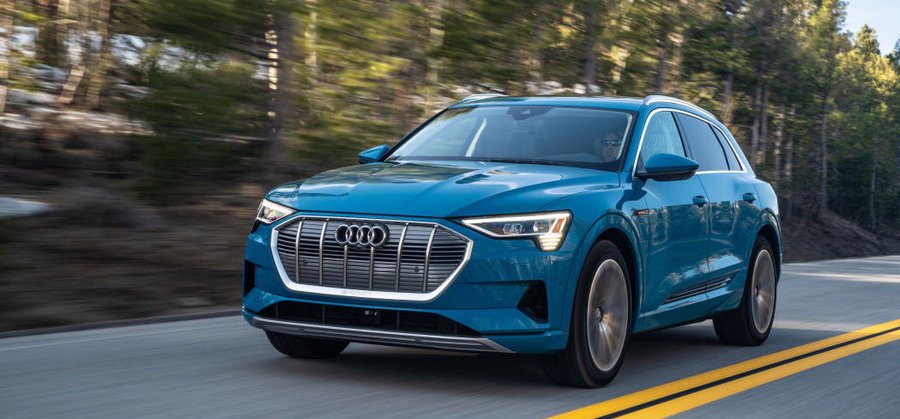How Mercedes-Benz and Audi designed their electric SUVs

Mercedes-Benz and Audi are both stepping into the production electric vehicle (EV) category in the United States in the next year, and they are both doing so, initially with an SUV – the 2020 EQC and the 2020 E-Tron, respectively. Like most marketing decisions in the automobile industry – where developing a single platform can cost a billion or more dollars and take up to a decade – this is not a coincidence. It is a very intentional decision based on market considerations; the world cannot seem to get enough high-riding, all-wheel drive, hatchbacked cargo haulers.
But it is also a key design decision. This is all the more important because both brands are producing vehicles that launch new sub-brands (EQ and E-Tron.) Though these vehicles differ slightly in size and price, the brands' approach to designing these vehicles is very similar.
The EQC, will be available in the states in the first quarter of 2020, and while EPA certification and pricing have not yet been announced, our sources indicate that it will have a range of over 200 miles and a price that starts in the high $60,000 range. It will also feature a shape that is eminently familiar.
"It looks like a normal, high-riding SUV," says Robert Lesnik, head of exterior design for Mercedes-Benz. "This is one of the great things about electrifying an SUV, you just put a battery underneath, and you're done!"
This familiarity is not an accident. It is part of the brand's strategy for coaxing customers into SUVs. "If someone wants to get in an EV, and make a statement, they deserve to be noticed in some ways," Lesnik says, describing how this new sub-brand will be differentiated subtly, with new lighting signatures and blue and blacked-out design cues.
"But we should never do a car that is simply a provocation. A Mercedes should have great stance, broad shoulders, excellent proportions, something you want to touch. But we don't want it to be love it or hate it."
Though Audi's vehicle will be larger and more expensive when it goes on sale here this summer, starting in the mid-$70,000s, the four-ring brand is taking much the same conservative route with its 200 mile-range E-Tron in terms of shape.
"For an electric vehicle, the design needs to be super aerodynamic. This is mandatory because in an EV you have limited energy, and a better coefficient of drag increases range. But the sales people told us that it needed to appeal to not only early adopters but to a broad audience as well," says Andreas Mindt, Audi's head of exterior design. "So we started with a more slippery car, but we ended up doing two cars. One is an SUV that appeals to a broader audience. The next is a coupe that has a more slippery figure, which you will see soon."
All of this may give the indication that both companies are simply designing around their staid, stolid pasts – and that is, in part, true. This is especially valid with respect to their joint decisions to retain a "grille" up front, despite the lack of the need to cool an engine.
Mercedes has its own reasoning for this. "Other companies have gone without a grille," Lesnik says. "But other companies don't have the heritage that we do – they didn't invent the car 130 years ago."
Audi has a different thinking regarding the inclusion of its traditional (if inverted) single-frame grille. "There is a misunderstanding that electric cars don't need to be cooled. This is not true," says Mindt. "When you have a car that can charge up for a long rate at high power – 150 kilowatt hours for up to 80% of the charge – you need to cool all of the technical elements. The engine, the battery charger, the battery itself. You need cooling."
Both brands have also purposely shied away from shrinking the hood and creating a cab forward, steeply raked windshield shape like the Jaguar I-Pace and Tesla Model Y, despite there not being a large engine up front.
"It's an SUV and that two-box convention is quite solidly defined for consumers. There is no need to change the proportions," Lesnik says. "You need to communicate a certain power. You want to sit higher. There is already plenty of room for people and all of their cargo."
Audi's reasoning is similar, but slightly different. "With a fast windshield, the interior is heating up faster because of sun," says Mindt. "And since you have limited energy, this is more difficult to cool down. An upright screen actually helps you more than a lying down one."
But Lesnik believes that all of this adherence to convention will change in the near future, as the EVs move rapidly into other segments. "We've said that in the next two to three years, there will be at least ten EQ cars," he says. "This will change completely with a lower car. You can get rid of a big bonnet since you no longer need to house eight or twelve cylinders, and give this room over to the passenger compartment. This will be next."
Both brands believe that EVs are likely to become far more popular in the next ten years, and even begin to move into the majority in the marketplace. This will give these vehicles the potential, very soon, to become the new standard-bearer for automotive design.
"In the next two generations, as things really shift over to EVs, we will see what happens with car design," Lesnik says. "Maybe EVs will become the new convention, and internal combustion engines will start to look more like EVs."


